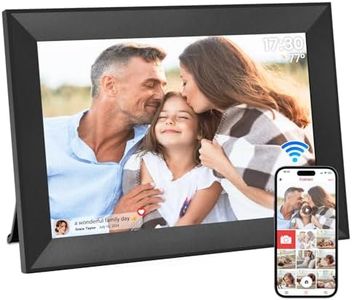We Use CookiesWe use cookies to enhance the security, performance,
functionality and for analytical and promotional activities. By continuing to browse this site you
are agreeing to our privacy policy
10 Best Digital Frames
From leading brands and best sellers available on the web.Recommended lists
Buying Guide for the Best Digital Frames
Digital frames are a modern way to display your favorite photos without the need for printing. They offer the convenience of easily changing the displayed image and can often store hundreds or even thousands of photos. When choosing a digital frame, it's important to consider several key specifications to ensure it meets your needs and preferences. Understanding these specifications will help you select a frame that not only fits your aesthetic but also functions well in your intended environment.Screen SizeScreen size refers to the diagonal measurement of the display area of the digital frame. This is important because it determines how large your photos will appear. Screen sizes can range from small, portable frames around 7 inches to larger, more stationary frames up to 15 inches or more. If you plan to place the frame on a desk or small shelf, a smaller size might be more appropriate. For a more prominent display, such as on a wall or large table, a larger screen size would be more suitable.
ResolutionResolution indicates the number of pixels that make up the display, affecting the clarity and detail of the images. Higher resolution means sharper and more detailed images. Common resolutions include 800x600 for smaller frames and up to 1920x1080 or higher for larger frames. If you want crisp, clear images, especially on larger screens, opt for a higher resolution. For smaller frames or if image detail is less critical, a lower resolution may suffice.
Storage CapacityStorage capacity refers to how many photos the digital frame can hold. This can be internal storage or expandable via memory cards or USB drives. Larger storage capacities allow you to store more photos, which is useful if you want to frequently change the displayed images without needing to upload new ones constantly. Consider how many photos you want to display and whether you prefer to update them often or have a large selection available at all times.
ConnectivityConnectivity options determine how you can upload photos to the digital frame. Common options include USB, SD card slots, and Wi-Fi. Wi-Fi-enabled frames allow for easy photo uploads from your smartphone or computer and can even connect to cloud services. If you prefer convenience and the ability to update photos remotely, a frame with Wi-Fi connectivity is ideal. For more straightforward use, USB or SD card options might be sufficient.
Aspect RatioAspect ratio is the proportional relationship between the width and height of the display. Common aspect ratios for digital frames are 4:3 and 16:9. A 4:3 ratio is closer to the dimensions of most digital camera photos, while 16:9 is more suited for widescreen images. Choose an aspect ratio that matches the majority of your photos to avoid cropping or distortion. If your photos vary, look for a frame that can adjust to different aspect ratios.
Additional FeaturesAdditional features can enhance the functionality and enjoyment of a digital frame. These may include touch screens, motion sensors, remote controls, and the ability to play videos or music. Consider which features are important to you. For example, a motion sensor can save energy by turning the frame off when no one is around, while a touch screen can make navigation easier. Choose features that align with how you plan to use the frame.















